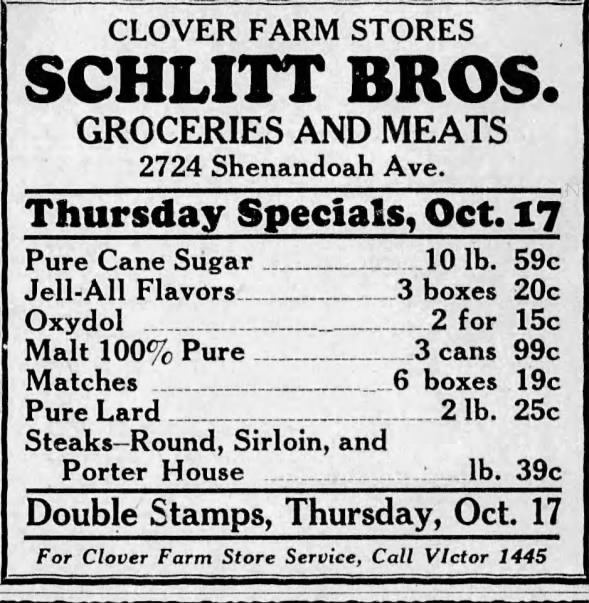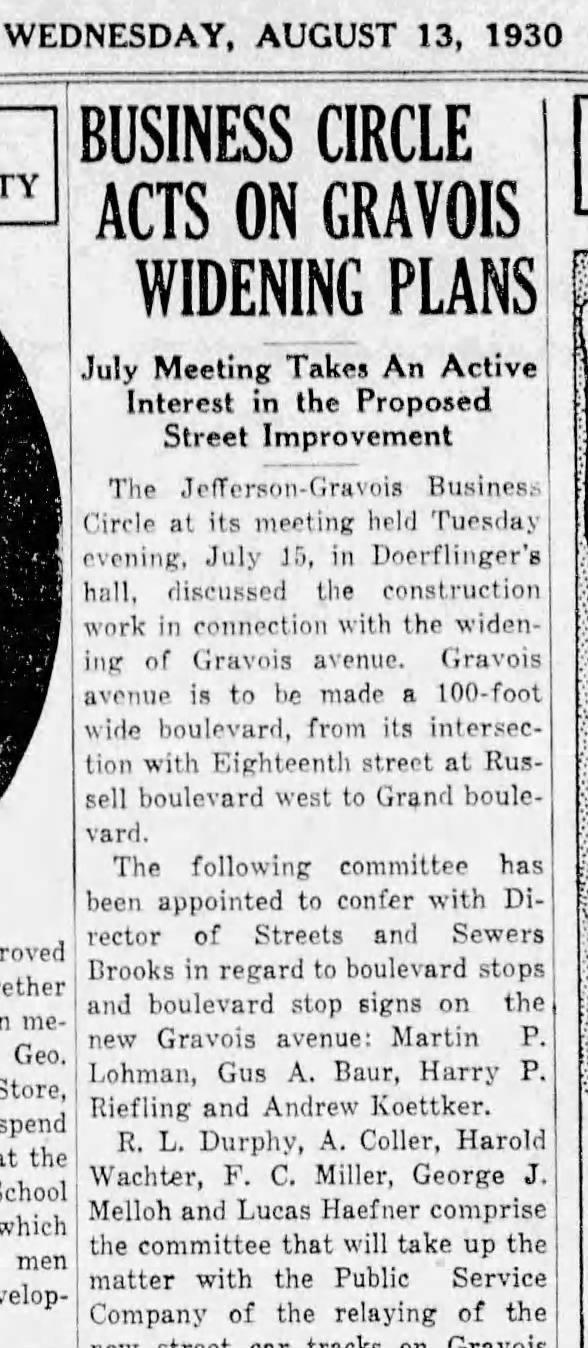I recently got a subscription to Newspapers.com. A favorite publication available therein is the Jefferson-Gravois Business Circle. It deals with the business community in what is now the Benton Park, Benton Park West, Fox Park and McKinley Heights Neighborhoods.
These publications from 1925-1931 are available on Newspapers.com.
I’ll share some of the stories or businesses that caught my eye.
I always walk by empty storefronts wondering what was once here, what happened and how much we’ve lost as a city and society when our cities emptied out for the lust of modernization and new housing. Suburbanization, the car and now online retail have crushed cities and that walkable feel.
As I read through these publications, I can’t help but pine for those days. But, make no mistake, it’ll never return at the scale it once was. But, recent years have shown an uptick in dignified businesses in this area, showing that there is hope for a more attractive, healthy intersection.
Anyhow, here are some items that stuck with me.
The above gave me a chuckle as my 1980s TV memories came rushing in where monster truck rallies and other hoosier pursuits were loudly advertised on Channel 11 and other stations. In gruff, macho voice, you’d get blared at: “Sunday, Sunday, Sunday, at the Checkerdome, Monster Trucks!”.
Now, I’m not judging anyone on their choices of entertainment, I have attended one of these as a kid and I was in awe of the spectacle.
These ads were minor variations of the same theme all over the country. Here’s an example of what I mean:
There were charming traditions in the 1920s and 30s that give you insight into how people lived and what they did to entertain themselves. After reading the following ad, I had to google “loving cup”, and now I’ll have this memory in my head whenever the Rolling Stones’ Exile on Main Street classic hits the needle on my turntable.
Check this out, “Ladies, do you get the point?”.
Reading the business stories and advertisements gave me insight into what was here and what people were spending their money on.
So much community, coolness, variety and city was lost due to suburban, auto-centric land uses and designs. The variety of businesses, stores and services was diverse and rich back in the 1920s and 1930s. You could get a violin, groceries, hardware, furniture, candy, gifts and pharmaceuticals all in the same block.
Heck, you could even pick up a Gene Autry or Louis Armstrong record and a gross of bottle rockets at he same time. Perusing records and fireworks under the same roof sounds like a childhood dream for any pre-teen boy. Take all my money!
The Jefferson-Gravois intersection was a major business hub and streetcar stop. As cars exploded into American culture, it later became an auto dealership and repair hub.
The strip of businesses that exist today on South Jefferson, now include a cell phone store, tattoo parlor, coffee shop and restaurant used to be almost entirely automotive services. That legacy is still visible. You can walk into Coffee Stamp and see the old conveyor belt system designed to move tires and auto parts from the upper floors to street level. They chose to keep it and explained that they can actually use it for their coffee operations.
When you look at the surrounding neighborhoods, there were businesses on nearly every corner in Fox Park. By the 1920’s, the car was closing in on replacing street cars and you can tell by the number of businesses catering to the personal automobile. A building at 2700 Ann used to be a tire shop.
The above is just one example of intra-neighborhood businesses, but I found they were all over. All long gone a generation or two later, of course.
Where the Fox Park softball field now sits, there were businesses. Here’s and example of a small grocery store at 2724 Shenandoah from 1929.
Need a radio, refrigerator or vacuum cleaner? Head to California and Russell.
This building on California is long gone and sent to the landfill. Ever since I’ve lived in Fox Park, it has been a vacant lot owned by a small Black Christian church.
The list goes on and on. By scouring these ads, you quickly find that our neighborhoods were teeming with small business. It was varied and on nearly every block.
Take a look at the Jefferson-Gravois intersection today. Predatory lending/check cashing joints, a weird 7-11, crappy gas stations (one no longer selling gas it appears), chain fast food drive thrus…it has completely been destroyed and cheapened.
It’s a trashy intersection, save for the former bank at the south east area.
A drive through, massive surface parking lot chain fried chicken joint owned by a suburban company used to be the Gravois Theater.
Image source: Missouri Historical Society
And before that, here’s how the Jefferson-Gravois intersection looked in 1926.
Image source: Missouri Historical Society
This dense, diverse business community existed well into the mid-20th Century as the following William Swekosky photo from the 1940s-50s shows.
Image source: Missouri Historical Society
Today you have a dangerous, high-speed intersection where you BEST check for no-dignity, selfish drivers blowing red lights before you hit the accelerator on a green light. Crossing on foot or bike? Be careful.
Well, this didn’t happen overnight.
The legacy of the massive, overly-wide Gravois and Jefferson corridors was discussed dating back to 1930.
So I’ve been obsessed with reading about St. Louis, and specifically, my current neighborhood back in the early 20th Century. It’s been fun, and a worthy distraction this winter.
One of the frustrations of St. Louis living is the constant reminder of how much we’ve messed up over the years. It continues to this day. Of course, things change and we can get better along Jefferson.
I’ve seen some recent signs of positivity. Let’s hope there’s more on the horizon. We can rebuild our once dense, diverse city.
Our city can return to one built for us, the residents. We chose high speed thoroughfares to get workers in and out of Downtown to the suburbs. We can reverse this if there is will.
South Jefferson needs a road diet, BRT or modern streetcars a la Kansas City or Cincinnati.














